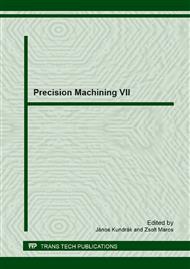[1]
D.G. Yevseyev, A.A. Vereshchaka, F.Y. Popov. Features of application of nanostructured carbide inserts with wear-resistant coating for machining rail components. Proceedings of the scientific-practical conference "Security of trains, Part 2, Book 2. - Moscow Engineering, 2007. pp.28-25.
Google Scholar
[2]
N.V. Talantov. Physical basis of the cutting and tool wear. Publisher of VTU, Volgograd, 1994. pр. 3-37.
Google Scholar
[3]
A.S. Vereschaka, V.S. Kushner. Cutting of materials. Moscow. High School Ed., 2009. 535 p.
Google Scholar
[4]
Vereschaka A.A., Vereschaka A.S., Grigoriev S.N., Kirillov A.K., Khaustova O.U. Development and research of environmentally friendly dry technological machining system with compensation of physical function of cutting fluids. Procedia CIRP 7 ( 2013 ) Elsevier B.V. p.311.
DOI: 10.1016/j.procir.2013.05.053
Google Scholar
[5]
M.U. Kulikov, M.A. Larionov. Improved Accuracy of Console Borig of Deep Aperturs. Key Engineering Materials Vol. 496 pp.194-200.
DOI: 10.4028/www.scientific.net/kem.496.200
Google Scholar
[6]
A.S. Vereschaka. A.A. Vereschaka. A.K. Kirillov. 2012. Ecologically friendly dry machining by cutting tool from layered composition ceramic with nano-scale multilayered coating. Key Engineering Materials Vol. 496 pp.67-74.
DOI: 10.4028/www.scientific.net/kem.496.67
Google Scholar
[7]
Vereschaka Alexey. Improvement of working efficiency of cutting tools by modifying its surface properties by application of wear-resistant complexes. Advanced Materials Research Vols. 712-715 (2013).
DOI: 10.4028/www.scientific.net/amr.712-715.347
Google Scholar
[8]
G. Byrne, D. Dornfeld, B. Denkena. 2003. Advancing Cutting Technology. Annals of the CIRP, 52/2/2003. (In English).
DOI: 10.1016/s0007-8506(07)60200-5
Google Scholar
[9]
W. Konig, F. Klocke. 2007. Fertigungsverfahren: Drehen, Frasen, Boren (Springer, Berlin) (In German).
Google Scholar
[10]
S. N. Grigoriev, A.A. Vereschaka, A.S. Vereschaka, A.A. Kutin. Cutting tools made of layered composite ceramics with nano-scale multilayered coatings. 5th CIRP Conference on High Performance Cutting. Procedia CIRP 1 ( 2012 ) Elsevier B.V. с. 318 – 323.
DOI: 10.1016/j.procir.2012.04.054
Google Scholar
[11]
A.S. Vereschaka, A.A. Vereschaka. 2010. Functional coatings for an edge cutting tools. - M. 2010. Technology of hardening and coatings. N 6. pp.28-37.
Google Scholar
[12]
K.D. Bouzakis, N. Michailidis, G. Skordaris, E. Bouzakis, D. Biermann, R. M'Saoubi. Cutting with coated tools: Coating technologies, characterization methods and performance optimization. CIRP Annals - Manufacturing Technology 61 (2012) 703–723.
DOI: 10.1016/j.cirp.2012.05.006
Google Scholar
[13]
A. A. Vereschaka, A. S. Vereschaka, S. N. Grigoriev, D.V. Sladkov. Nano-Scale Multi-Layered Coatings for Cutting Tools Generated Using Assisted Filtered Cathodic-Vacuum-Arc Deposition (AFCVAD). Applied Mechanics and Materials Vols. 325-326 (2013).
DOI: 10.4028/www.scientific.net/amm.325-326.1454
Google Scholar


